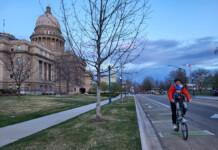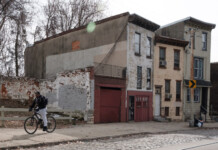The first new official routes in almost 30 years herald growing momentum for U.S. Bicycle Route System
Missoula, Montana — Adventure Cycling Association and the American Association of Highway and Transportation Officials (AASHTO) today announced that AASHTO’s Special Committee on U.S. Route Numbering has approved six new U.S. Bicycle Routes (USBR): USBR 1 in Maine and New Hampshire, USBR 20 in Michigan, and USBR 8, 95, 97, and 87 in Alaska — the first official U.S. Bicycle Routes to be established since 1982.
AASHTO and Adventure Cycling welcomed approval of these new routes as a momentous step toward creating an official U.S. Bicycle Route System (USBRS), which will become the largest official national cycling network on the planet.
“We are pleased that the collaboration with Adventure Cycling has resulted in the approval of these new bicycle routes and we look forward to continuing the implementation of the national corridor plan that was endorsed by AASHTO’s membership in partnership with the bicycling community,” said John Horsley, AASHTO’s Executive Director.
The new routes have been under development since AASHTO’s Board of Directors approved the national corridor plan for the USBRS — a template for planning interstate bicycle routes across the country — in October 2008.
“The day after AASHTO approved the corridor plan, volunteers contacted our office and asked if they could start developing USBR 20 from Marine City to Ludington,” commented Josh DeBruyn, bicycle and pedestrian coordinator for the Michigan Department of Transportation (DOT). “Management supported the idea that this project would be a grassroots effort, and it’s worked out tremendously.”
In coordination with the Michigan DOT, and working as volunteers for Michigan Trails and Greenways Alliance, supporters Scott Anderson and Kerry Irons pioneered Michigan’s grassroots model for implementing U.S. Bike Routes: first by winning buy-in from local communities and transportation agencies, and then securing route number approval from AASHTO, a required step for all U.S. Bike Routes. AASHTO is a nonprofit, nonpartisan association representing highway and transportation departments in all 50 states, the District of Columbia, and Puerto Rico. A powerful voice in the transportation sector, its primary goal is to foster the development of an integrated national transportation system. AASHTO’s support for this project is crucial in earning the support of federal and state agencies, and provides a major boost to bicycling and route development for non-motorized transportation.
“It’s an important achievement,” said Ginny Sullivan, special projects director and USBRS project coordinator at Adventure Cycling Association. “We’ve appreciated Michigan’s very methodical approach over the past two and a half years, providing a model for other states to be successful in their efforts.” Adventure Cycling provides technical assistance to states working on route implementation.
Michigan’s USBR 20 begins and ends with ferry rides: over 40 miles of Lake Michigan open water from Manitowoc, Wisconsin, to the port of Ludington, Michigan, and three-quarters of a mile across the St. Clair River to Ontario, Canada, from Marine City, Michigan. In between are glacial hills and flat prehistoric lake bottoms of central Michigan. USBR 20 mostly follows quiet, rural, country roads and includes over 45 miles of separated pathways, including the 30-mile Pere Marquette Rail-Trail. The western section of the route features the Manistee National and Pere Marquette State Forests, insuring that cyclists will get a strong dose of “pine tree perfume” as they ride. The route is the essence of small-town, rural communities anxious to host traveling cyclists. Plus, riders get to visit Frankenmuth, (“Michigan’s Bavaria”) and ride through its covered bridge.
Similar to Michigan, Maine’s Department of Transportation worked with local cyclists to develop U.S. Bike Route 1 from Calais to Portsmouth. “We looked at many options: Adventure Cycling’s Atlantic Coast Route and the East Coast Greenway. We came up with what we thought would provide the best touring route while making important connections to Maine’s coastal cities and scenic destinations,” says Tony Barrett, a dedicated local cyclist active with the Bicycle Coalition of Maine.
Maine’s USBR 1 begins on an historic bridge just upriver from the Portsmouth Naval Shipyard, a symbol of the state’s rich maritime history. The route follows low-traffic roads connecting many of Maine’s major towns and cities. In Portland, the route follows the Eastern Promontory shore with views of the many islands in Casco Bay. Farther north, USBR 1 follows sections of the state’s three major rivers with historic forts and many mills. In Bangor, Maine’s second largest city, the route passes by the large statue of Paul Bunyan, a testament to the region’s forest products industry along the mighty Penobscot River. (An alternate route, U.S. Bike Route 1A, follows the coast more closely connecting to many harbor towns.) After passing Acadia National Park, USBR 1 continues northeast along the less visited and less-developed “Downeast” coast en-route to the border crossing into New Brunswick. USBR 1 and the coastal alternate are also segments of the East Coast Greenway.
Maine’s DOT conducted a series of public meetings to get consensus from local communities about establishing the new route. “Maine communities recognize the important economic benefits bicycle tourism brings to the state and they welcome travelers, wherever they may hail from,” commented Dan Stewart, bicycle and pedestrian program manager for the DOT.
In all of these states, tourism and economic development revenue were oft-cited goals for communities joining the effort to establish these new routes. For example, as resolutions of support from the communities along USBR 20 arrived at the DOT office in Michigan, the common component was the economic benefits these tourism and transportation corridors will provide to the cities and towns along the route.
Bicycle travel is becoming an increasingly visible part of the adventure travel market, which, according to a recent study issued by the Adventure Travel Trade Association, generates $89 billion annually. In January 2010, researchers at the University of Wisconsin calculated that out-of-state visitors traveling to Wisconsin for great cycling opportunities generated $532 million, or more than half-a-billion dollars, in economic activity. With in-state touring cyclists, the total economic impact is close to $1 billion. Academics and advocates in Minnesota recently issued studies finding a similar $1 billion economic development boost generated by on-road and off-road cycling. The State of Oregon has embarked on a similar study and expects its survey to come out later in 2011.
Maine’s route connects to New Hampshire’s Seacoast region and the New Hampshire Seacoast Greenway. The Greenway has been established in New Hampshire for a number of years and is also used as the East Coast Greenway through New Hampshire. “We discussed the off-state system routes with the local jurisdictions. Their preference was to use the East Coast Greenway route, which the municipalities had already evaluated with the cooperation of the seacoast area cycling community,” said Larry Keniston, intermodal facilities engineer with the New Hampshire DOT.
Several new routes were also approved for Alaska. Starting with the land-based route connecting through Canada, USBR 8 is the Alaskan Highway, which runs from Dawson Creek, British Columbia, via Whitehorse, Yukon, through Delta Junction terminating in Fairbanks. An alternate route from Tok to Anchorage is numbered USBR 108 and the section near Haines is alternate USBR 208. The Alaska Highway is popularly (but unofficially) considered part of the Pan-American Highway, which extends south to Argentina. USBR 95 is the Richardson Highway from Delta Junction to Valdez where the route connects to Washington via the ferry system, also known as the Alaska Marine Highway. A north/south route, USBR 97, runs from Fairbanks through Anchorage to Seward. The Fairbanks to Anchorage section of the route follows the Parks Highway and crosses the entrance to Denali National Park. Another route near Skagway, the home of theKlondike Gold Rush National Historic Park was approved as USBR 87, which will also connect to Washington via the Alaska Marine Highway. Alaska submitted their original application to AASHTO last fall, however, route numbers for the state had yet to be developed by the Task Force on U.S. Bicycle Routes. In the weeks leading up to the AASHTO spring meeting, the task force worked with the state of Alaska on the numbering system that was accepted and endorsed by the committee. ”We are excited to be able to promote bicycle tourism in the state of Alaska. We have fabulous vistas and low-traffic highways that beg exploration,” says Bob Laurie, transportation planner and bicycle and pedestrian coordinator. “Connecting to Washington State via the ferry system and collaborating with Canada is next on our list.”
The Virginia DOT has been working over the past year to update their U.S. Bicycle Routes, submitting two applications for realignment in the fall of 2010. This spring, they updated sections of USBR 1 and USBR 76, and last week, AASHTO’s Special Committee on U.S. Route Numbering also approved these realignments.
“We are taking advantage of emerging bicycle infrastructure as it becomes available, and making adjustments out of necessity in order to provide safer alternatives,” said Liz McAdory, policy and planning specialist for the DOT. “We are also working with our districts to continue to sign our existing two U.S. Bicycle Routes — 1 and 76. Our department has a long-standing working relationship with bicycle advocates, especially the Virginia Bicycling Federation. Through this partnership, we’ve been able to identify necessary changes and update the routes, and will continue to do so.” USBR 76 is also known as the TransAmerica Trail, the first mapped cross-continental cycling route in the U.S., produced by Adventure Cycling in 1976.
The U.S. Bicycle Route System is a proposed national network of bicycle routes that span multiple states and are of national and regional significance. These routes will serve as visible and well-planned trunk lines for connecting city, regional, and statewide cycling routes, and provide transportation and tourism opportunities across the country.
A highly collaborative effort, the U.S. Bicycle Route System project is spearheaded by AASHTO’s Task Force on U.S. Bicycle Routes and involves officials and staff from state DOTs, the Federal Highway Administration, and nonprofit organizations such as Adventure Cycling, the East Coast Greenway Alliance, and Mississippi River Trail, Inc.
Adventure Cycling has provided dedicated staff support to the U.S. Bicycle Route System project since 2005, including mapping and research support, as well as technical guidance to states implementing routes. Support for Adventure Cycling’s work on the project has come from its members and donors, Bikes Belong, the SRAM Cycling Fund, the Lazar Foundation, New Belgium Brewing, the Surdna Foundation, and AASHTO’s Center for Environmental Excellence.
When complete, the U.S. Bicycle Route System will be the largest official bike route network on the planet, encompassing more than 50,000 miles of routes. Learn more at www.adventurecycling.org/usbrs.







